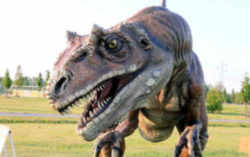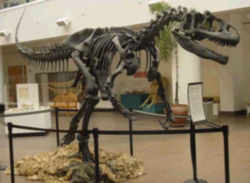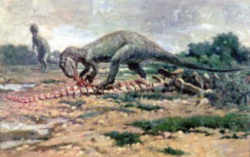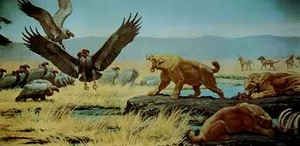
Utah Symbols
Utah State Fossil
Theropod Dinosaur

(Allosaurus fragilis)
Adopted in 1988.
The Theropod Dinosaur, (Allosaurus fragilis,) was designated the State Fossil in 1988. There are different meanings of the word allosaurus, "Different Lizard" and "Strange Reptile," are two examples. Allosaurus was a carnosaur, one of the groups of theropod meat-eaters. This animal was large and probably too bulky to move at speed over any distance, however, the large sauropods and stegosaurs on which it fed were not fast-moving themselves. It measured around 16.5 ft. in height and 39 ft. in length and its skull more than 3 ft. long; its jaws were lined with serrated, back-curved teeth and it weighed in at about 4 tons.
Utah State Fossil: Theropod Dinosaur

One of the largest Jurassic Carnosaurs of North America. An average Allosaurus weighed about 4 tons (3.6 metric tons) and measured 35 feet (10.5 m) from the tip of its nose to the end of its TAIL. The largest known was 45 feet (13.5 m) long. When Allosaurus stood upright, it was 16.5 feet (5 m) tall.
Allosaurus was a carnivorous "lizard-hipped" dinosaur or theropod. It had a bony red crest above each eye, a strong s-shaped neck. Its teeth were 5-10 cm long and curved backward with serrated front and back edges. Allosaurus' strong back and neck aided its jaws in tearing off chunks of flesh.
Like all Theropods, Allosaurus Walked on two legs with its heavy tail stretched out behind for balance. Its strong legs were built for speed; they
had powerful muscles and heavy bones. Although its arms were short, each finger on its three-fingered hands was armed with a sharp claw that could
be up to 6 inches (15 cm) long. The three long toes on its feet were equipped with eagle-like talons.
This meat eater had a strong neck. Its huge 3-foot (90 cm) long head had heavy bony knobs, or ridges, above its eyes; its enormously powerful jaws
were filled with saber-like teeth 2 to 4 inches (5 to 10 cm) long. The jaws were hinged like those of a snake, so Allosaurus would have been able to
swallow huge hunks of meat whole. Scientists have found APATOSAURUS vertebrae with Allosaurus tooth marks on them, evidence of a Jurassic feast! Although
not really built for speed, it had two sturdy legs and a powerful tail. It was a fearsome predator of its time.
The genus Allosaurus is based on the virtually complete skeleton discovered by M. P. Felch in 1883.
More than 60 complete and partial Allosaurus skeletons have been recovered from the Morrison Formation between Wyoming and New Mexico, in the USA.
It is the largest and most common carnivore found in these widespread deposits. At the Cleveland Lloyd Quarry in Utah, USA, Allosaurus is by far the
most numerous fossil type and is represented by at least 44 individuals. These ranged in size from adults to juveniles.
Characteristics of the Allosaurus

Allosaurus was the most common large
carnivore of the Late Jurassic in North America. It was a smaller predecessor of the Cretaceous Tyrannosaurus. Strong forelimbs with sharp claws, powerful
hind legs and recurved, dagger-like teeth are evidence that Allosaurus was a formidable predator. Although it was much smaller than sauropods like
Apatosaurus (Brontosaurus), which were also common at the time, quite possibly Allosaurus hunted in packs to bring down larger prey. Like many meat
eaters, it may also have been a scavenger.
Many Allosaurus specimens representing individuals of different ages have been recovered in exposures of the Morrison Formation in the Rocky Mountain
West. This specimen is interpreted as a sub-adult.
Geologic Time: 145 to 150 million years ago (Late Jurassic)
Geographic Range: Wyoming, Montana, Colorado, New Mexico, South Dakota, Utah, and Oklahoma
Adult Weight: 1.5 - 2 tons
Adult Length: 30 - 40 ft long
Habitat: Plains and lowlands
Diet: Meat
Utah Law
The law designating the Theropod dinosaur as the official Utah state fossil is found in the Utah Statutes, Title 63, Chapter 13, Section 63-13-5.5.
TITLE 63. State Affairs in General.
CHAPTER 13. Miscellaneous Provisions.
SECTION 63-13-5.5. State Symbols.
63-13-5.5. State symbols.
(1) Utah's state animal is the elk.
(2) Utah's state bird is the sea gull.
(3) Utah's state centennial astronomical symbol is the Beehive Cluster located in the constellation of Cancer the Crab.
(4) Utah's state centennial star is Dubhe, one of the seven bright stars composing the Big Dipper in the constellation Ursa Major.
(5) Utah's state centennial tartan, which honors the first Scots known to have been in Utah and those Utahns of Scottish heritage, shall have a pattern
or repeating-half-sett of white-2, blue-6, red-6, blue-4, red-6, green-18, red-6, and white-4 to represent the tartan worn anciently by the Logan and
Skene clans, with the addition of a white stripe.
(6) Utah's state cooking pot is the dutch oven.
(7) Utah's state emblem is the beehive.
(8) Utah's state fish is the Bonneville cutthroat trout.
(9) Utah's state flower is the sego lily.
(10) Utah's state folk dance is the square dance, the folk dance that is called, cued, or prompted to the dancers and includes squares, rounds, clogging,
contra, line, and heritage dances.
(11) Utah's state fossil is the Allosaurus.
(12) Utah's state fruit is the cherry.
(13) Utah's state vegetable is the Spanish sweet onion.
(14) Utah's historic state vegetable is the sugar beet.
(15) Utah's state gem is topaz, as is prominently found in the Thomas Mountain Range in Juab County, Utah.
(16) Utah's state grass is Indian rice grass.
(17) Utah's state hymn is "Utah We Love Thee" by Evan Stephens.
(18) Utah's state insect is the honeybee.
(19) Utah's state mineral is copper.
(20) Utah's state motto is "Industry."
(21) Utah's state railroad museum is Ogden Union Station.
(22) Utah's state rock is coal.
(23) Utah's state song is "Utah This is the Place" by Sam and Gary Francis.
(24) Utah's state tree is the blue spruce.
Taxonomic Hierarchy: Allosaurus
Kingdom: AnimaliaPhylum: Chordata
Order: Saurischia
Suborder: Theropoda
Clade: †Carnosauria
Family: †Allosauridae
Subfamily: †Allosaurinae Marsh, 1877
Genus: †Allosaurus Marsh, 1877
Type species
†Allosaurus fragilis Marsh, 1877
Species
†A. fragilis Marsh, 1877
†A. europaeus Mateus et al., 2006
†A. lucasi Dalman, 2014

Some states that lack a "state fossil" have nevertheless singled out a fossil for formal designation such as a state dinosaur, rock, gem or stone.






